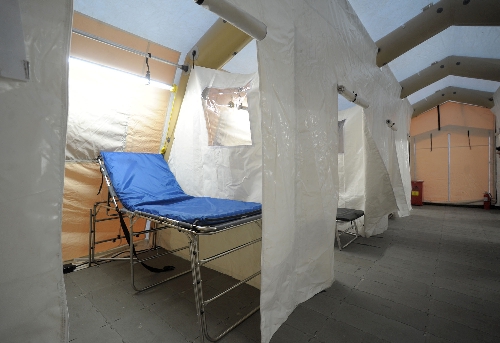Flu season has spared Nevada so far, but it won’t stay that way for long
If you live in Nevada, California, Hawaii, Montana, Connecticut, Kentucky, Maine, New Hampshire, South Dakota or Wisconsin - states reporting minimal levels of influenza - the way the British media characterize the flu season in the United States may seem more than a tad feverish.
"Flu infections sweep America hospitalizing thousands and leaving 18 children dead of complications, and it's going to get worse," a recent headline in the Daily Mail, the United Kingdom's second-largest newspaper, screamed to its 4 million readers.
If you live in the 40 other U.S. states, however, the British aren't engaging in journalistic hyperbole but are, in fact, pretty much on the mark, with many state officials fearing this could be one of the worst flu seasons in years.
Nearly 2,300 people have been hospitalized with the flu, and 18 children have died from ramifications of the virus. Positive cases of influenza in the United States rose 60 percent during the last week of December.
Officials with the surveillance and response team that monitors influenza for the federal Centers for Disease Control and Prevention's National Center for Immunization and Respiratory Diseases describe the outbreak as about five weeks ahead of the average flu season.
So why has Las Vegas, where people come from all over the nation and world to enjoy themselves, had only 12 confirmed cases in the past five weeks?
"We've been lucky so far," said Brian Labus, a senior epidemiologist with the Southern Nevada Health District. "We've had a typical start to our flu season. A lot simply depends on how people interact. It's been pretty slow."
Labus wouldn't bet on it staying that way, given experience with the virus in Nevada.
"We're probably a couple weeks away from being hit," he predicted, noting that with winter, when more people stay inside close quarters, the virus often spreads faster. "That's why it's important for people to get their flu shots now."
Labus said the current vaccine is a good protective match for the flu strain now in the country. In fact, when the CDC performed DNA testing on a sample of positive flu tests to compare it with the DNA of the three strains in the flu shot, only two of the 400 flu samples analyzed did not match the vaccine.
If what is happening across the country occurs in Nevada, it could mean trouble.
In Ohio, 863 people have been hospitalized with the flu, compared with 65 by this time in the 2011-2012 season. The number of people hospitalized in Minnesota is on track to reach as high a number as the state suffered in 2009 during the H1N1 pandemic ---- 1,800.
Since Oct. 1, the Southern Nevada Health District has administered 9,222 flu shots, compared with 11,901 during the same time frame last year. The number of flu shots given by other providers in Southern Nevada is not available.
"There is still plenty of vaccine available," said Stephanie Bethel, a spokeswoman for the district.
From January through Nov. 30 of last year, Southern Nevada had 369 cases of flu. In 2011, there were 459 confirmed cases of flu reported locally and 184 in 2010.
In 2009, when the H1N1 pandemic hit the country, an unusually high 5,557 cases of flu were reported in the Las Vegas Valley and a staggering 61 million estimated nationwide by the CDC.
Deaths from H1N1 hit 40 in Southern Nevada, and the CDC estimated as many as 18,000 died from the virus nationwide.
Health officials across the country say that three of four people now reporting flu symptoms had not been vaccinated.
In the week ending Dec. 29, the CDC reported 2,961 positive influenza test results out of 9,363 specimens nationwide, or 31.6 percent. Near the Great Lakes, the hardest-hit region, nearly 60 percent of those who were checked tested positive for the flu.
Labus noted that most people ride out the flu at home and are never tested for the virus.
Flu symptoms vary widely in severity. Some years have seen as many as 200,000 hospitalized and 3,000 to 49,000 dead.
Those most at risk for the flu are seniors, children and infants, and pregnant women.
Changes to a woman's immune system during pregnancy can make her more sensitive to the flu. This can result in serious problems for the unborn baby, including premature labor and delivery. Also, fever in early pregnancy can lead to birth defects. Pregnant women, Labus said, should get the flu vaccine as soon as possible.
Children are at higher risk for the flu because their immune systems are not fully developed.
Each year in the United States, an average of 20,000 children younger than 5 are hospitalized for flu-related complications. During the 2011-2012 flu season, 26 deaths of children were reported to the CDC, eight more than have been reported this season.
Because immune systems weaken with age, adults 65 and older are more susceptible to the flu. Ninety percent of flu-related deaths and more than half of flu-related hospitalizations occur in this age group.
Seniors have two options for vaccination: the regular dose flu shot and the high-dose shot that results in a stronger immune response.
Contact reporter Paul Harasim at pharasim@
reviewjournal.com or 702-387-2908.





























